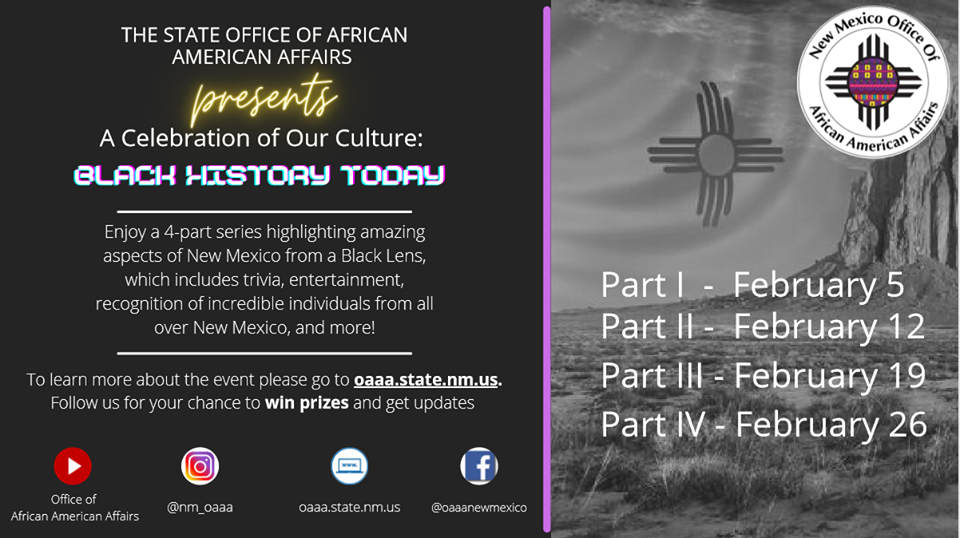
The New Mexico Office of African American Affairs is hosting a series of events focusing on the history of the Black experience in New Mexico every Friday in February.
Information on the first event happening on Feb 5th can be found HERE.


The New Mexico Office of African American Affairs is hosting a series of events focusing on the history of the Black experience in New Mexico every Friday in February.
Information on the first event happening on Feb 5th can be found HERE.
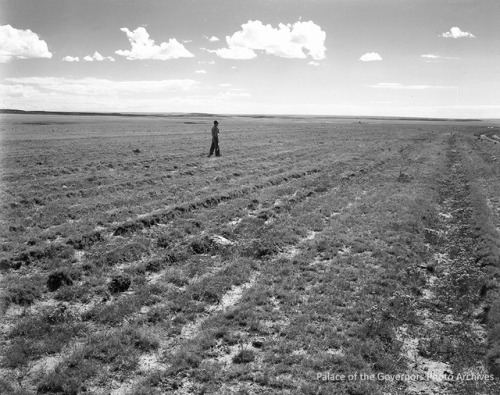
On this day in history, Jan. 29, 1822, William Becknell, founder of the Santa Fe Trail, returns to Franklin, Missouri, after his first trading expedition to Santa Fe. Legend has it that Spanish gold and silver coins fell from his leather pouch onto the streets, sparking a “trade rush.”
Museum curator Alicia Romero spoke with KRQE news about the research project about small independent businesses serving communities throughout New Mexico. We are seeking input from the public about their experience and memories of these small businesses which will help inform a future exhibit.
For more details and how to submit your own suggestion, check out this recent blogpost.
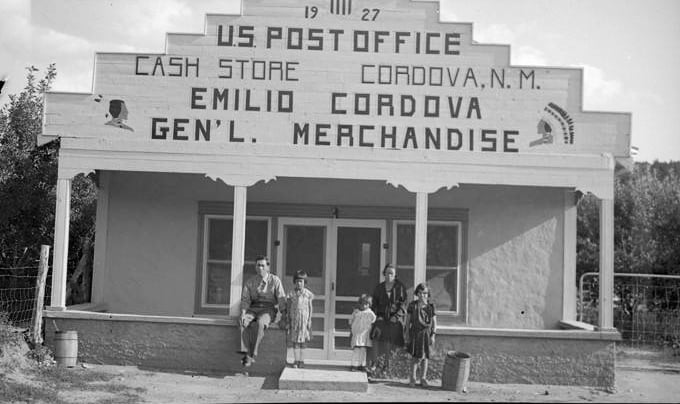
What’s your favorite New Mexico small business?
Were you the owner? Did your family run one for decades and decades? Did you work for one? Or did you just frequent a favorite shop around the corner?
The New Mexico History Museum is researching historic and modern small businesses to explore for a possible exhibition in the future.
New Mexico has many memorable and iconic establishments that would help to tell this story. In particular, we’d like to focus on sole-proprietor operations and family-owned businesses that sold goods or provided services to local communities in every part of the state.
(We’d like to avoid national chains and franchises.)
We’re looking for corner stores, tienditas, general stores, barber shops, moms & pops, cobblers, meat markets, bookstores, record stores, radio stores, repair shops, feed stores, trading posts, very small restaurants and cafes, tailors and seamstresses, laundries, bicycle shops, and so on, that were unique, characteristic, or served as anchors in their neighborhood or town.
Here’s a very simple form where you can add ideas from anywhere in the state.
https://forms.gle/wmuUvhfkVBjoyaBSA
Thanks for your help! Please spread the word to anyone who might be interested.
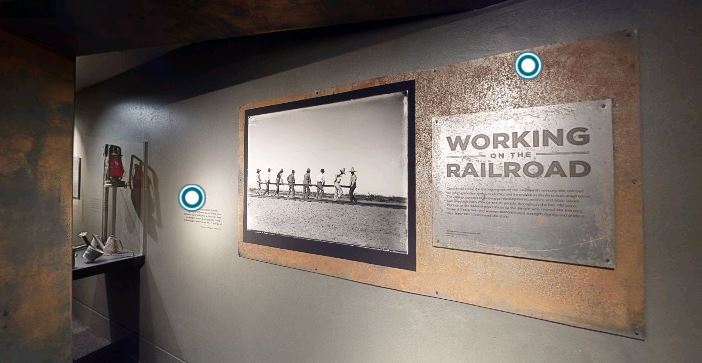
When the railroad came to New Mexico in 1879, it brought thousands of job opportunities for local people from rural villages, reservations, and larger towns. In addition to the homegrown workforce, the railroad also brought immigrant Chinese, European, and Mexican laborers to our state. The workforce included women and people of color, immigrants and Native Americans, young and old.
Told through historic and contemporary images from the Palace of the Governors Photo Archives and the The Library of Congress, “Working on the Railroad” fosters appreciation for these people—the steel gangs and machinists, car cleaners and conductors—included in the story of how the railroad changed New Mexico. Along with the photographs, artifacts such as oversized machinist’s wrenches, early twentieth-century railroad lanterns, brass locks, and railroad tie dating nails help the visitor imagine what it was like working on the railroad.
While we remain closed, please enjoy this virtual tour of NMHM’s “Working on the Railroad.” You can watch the New Mexico PBS ¡Colores! episode, “Albuquerque’s Historic Railroad Shops” from within the exhibition.
https://my.matterport.com/show/?m=z9uNNHsiPED
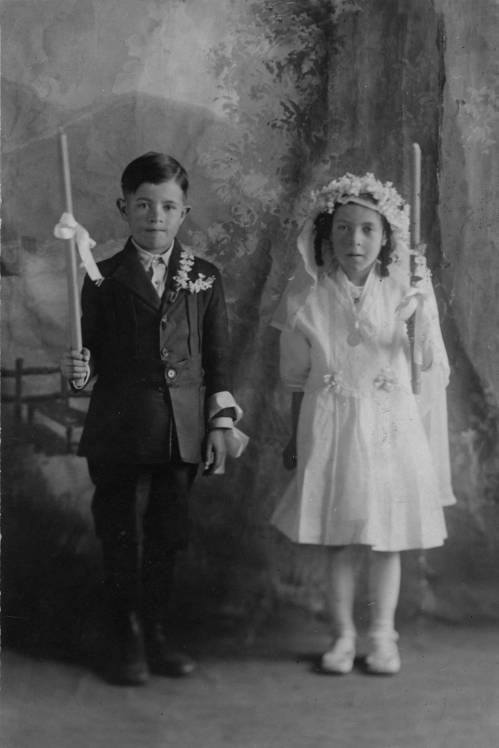
“My parents were the grandchildren of the founders of Wagon Mound, New Mexico. My Chavez grandfather was brought as a child from Belen. My mother’s side were Roybals from the Jacona district. Again, her father was brought as a child to Wagon Mound. I was born in 1910, exactly nine months after they were married–to the day. There were ten children in all.”
“From Mora to the Mission : Fray Angelico Chavez”, Turn Left at the Sleeping Dog: Scripting the Santa Fe Legend, 1920-1955 / by John Pen La Farge.
|
Four Centuries of History Welcome to the latest installment of our media-release series, “Telling New Mexico: Stories from Then and Now.” See the links below for previous releases, along with information about obtaining photographs to accompany your coverage.
Every year in Santa Fe, on the weekend after Labor Day, the city comes alive with the sounds of the past. Mariachis perform on the Plaza, and the cries of “Que Vivá!” ring out. The Fiestas de Santa Fe have been celebrated every autumn for 297 years to commemorate the Spanish reconquest of the City of Holy Faith in 1692. The stories behind the founding of Santa Fe, the Pueblo Revolt, and the Spanish reoccupation are just a shadow of the vibrant cultural history you’ll discover at the New Mexico History Museum, www.nmhistorymuseum.org, scheduled to open May 24, 2009. In 1680, just 70 years after the founding of Santa Fe by Don Pedro de Peralta, the Pueblo peoples of New Mexico rose up under a religious leader called Po’Pay. After a six-day siege of Santa Fe, the Pueblo peoples managed to drive the Spanish colonists back to El Paso del Norte, in present-day Juarez, Mexico. Twelve years later, the Viceroy of New Spain appointed Don Diego de Vargas as Governor-in-exile of New Mexico. Vargas set forth with a small band of soldiers and colonists to re-settle Santa Fe. In September 1692, Vargas accomplished this feat without bloodshed. Vargas returned to Mexico to recruit more colonists, and when he returned the following winter, the Pueblo peoples denied him reentry to the city. He then set up an altar for La Conquistadora, a 29-inch-tall statue of carved wood that had originally been brought to Santa Fe in 1625 and had returned with Vargas to Santa Fe. Vargas implored the Virgin Mary to intercede on behalf of the colonists, and before the end of December that year, he had gained re-entry to the city. Crediting La Conquistadora with his success, Vargas was said to have vowed to restore the statue to her throne in the local church, which had been destroyed by fire in 1680. He was unable to accomplish this during his lifetime. Eight years after Vargas’ death, Governor Marquez de la Peñuela signed the 1712 Proclamation, which established the first Fiesta de Santa Fe. The first Fiesta called for Mass, vespers, and a sermon, which began the religious tone of the Fiestas that continues today. There are, however, a number of non-religious traditions that have accumulated over the years. In 1924, local artist Will Shuster Jr. conceived and created the effigy of “Zozobra,” an old Spanish term that Vargas had used to describe “the adversities and perils of that government of New Mexico.” Today, locals are asked to write down their troubles on slips of paper weeks before Fiestas begin. The slips of paper are then stuffed into a 50-foot mannequin made of timber, muslin, and paper mache – Zozobra, or “Old Man Gloom.” The Kiwanis Club sponsors the annual event at Fort Marcy Park, complete with fire-dancers, fireworks, live music, and of course, the angry, deep-throated voice of Zozobra over the loudspeakers. It is said that all the troubles of the previous year go up in smoke with the burning of Zozobra. Following the burning of Zozobra, the three-day celebration of the Fiestas continue with the selection of a “Don” (Vargas) and a “Queen,” mariachi music on the Plaza, a number of dances and balls, the always charming Desfile de los Niños (a children’s pet parade), the Desfile de la Fiesta (also known as the historical/hysterical parade), a historical fashion show, Mariachi Mass, and a candlelight procession to the Cross of the Martyrs atop a hill overlooking downtown Santa Fe. The Fiestas de Santa Fe are a vibrant and living example of the cultures that have clashed and blended for over 400 years to make the people of New Mexico who they are today. The New Mexico History Museum explores not only the lives of conquistadors like Vargas, but also of Po’pay and the Pueblo peoples, Santa Fe Trail riders and fur-trappers, railroad men and cowboys of the 1800s, veterans of WWII, the scientists who built the bomb and the counterculture movement of the 1960s and ’70s. Define your own place in history: Get into it! This all-encompassing, family-oriented, 96,000-square-foot annex to the 400-year-old Palace of the Governors uses interactive multi-media displays in conjunction with images and artifacts to tell the stories of real New Mexicans – the people who are the West. For more information about the New Mexico History Museum, including a selection of user-ready high-resolution photographs, log onto http://media.museumofnewmexico.org/nmhm. More than 8,000 additional, high-resolution photographs illustrating the history of New Mexico are available by keyword search at www.palaceofthegovernors.org (click on “Photo Archives” then on “Digitized Collections”). Most requests for scans from this site can be delivered the same day, and usage is free for publicity purposes only. Previous releases: The Tales that Made the American West New Mexico History Museum’s Core Exhibits Telling the People’s Stories: A Message from the Director Creating a Place for Our Past, by Dr. Frances Levine, El Palacio, Summer 2006 Other Sites: Media Contacts: Rachel Mason |